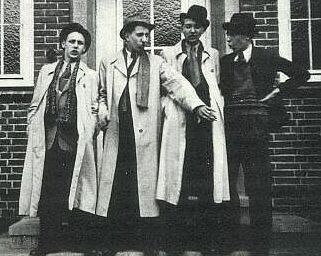
Unlike the Edelweiss Pirates who used aggression and more direct forms of resistance, the Swing Youth used a more cultural form of resistance. This is predominately due to the fact that the Swings were not anti-fascist but more opposed to the traditional music and lifestyles of the Nazi Party and Hitler Youth. In the novel, “No Nazi Party: Youth Rebels of the Third Reich,” author Tom Neuhaus explains, “The Swing Youths resented the rigid, conformist codes of behavior advocated by the Third Reich and pressed upon young Germans by the regime. ‘They expressed their rebellion in a number of ways, most obviously in terms of their dress and hairstyles,”’ (Neuhaus 1).
Further, the Swing Youth dressed extremely differently from their Hitler Youth counterparts. Neuhaus goes on to explain how the Swing’s look was deliberately different to the uniform of the Hitler Youth, which kept young people in shorts and somber brown shirts until the age of eighteen, their hair short (for boys) or in neat plaits (for girls). In resistance to this traditional appearance, Swing Youth boys had long hair often reaching to their shoulders; they also wore plaid jackets: a popular British trend. Further, they wore thick shoes, bright scarves, diplomat’s hats and an umbrella over their arm at all times – even in sunny weather.
Similar to the boys, Swing Youth girls tried to resist the conformity of the German Girls' League by emphasizing their individual femininity. The girls also preferred their hair long with their eyebrows penciled in. They brightly painted their lips and fingernails.
In addition to their rebellion in terms of appearance, the Swings showed cultural resistance through their choice in dance and music. They engaged in various activities including swing dance, based on the American Lindy Hop of the 1920s and ‘30s, which was practiced at a number of private and carefully chosen venues. In the book “Hitler Youth,” author Michael Kater describes, “Swing requires shoving your upper torso forward while shaking your lower body. ‘Many times 4-6 people danced and hopped around circles, knocking their hands together and even rolling their heads against each other,’” (Kater 142). This was juxtaposed to the strict Nazi party type of dance, where people were supposed to dance as if they had a stick up their spine.
The Swings further resisted the traditional music of the Nazis by listening to American and American-influenced styles of music. Kater goes on to describe how the “musical accompaniment was provided by indigenous German bands playing American Benny Goodman-type swing, sometimes of questionable amateur quality, but also by Dutch and Belgian professionals such as John Kristel or Fud Candrix orchestras,” (Kater 142). In the book “The Third Reich,” author David Welch describes how the swing youth, “rejected voelkische music and listen[ed] instead to jazz and swing music, which the authorities labeled as American-influenced Unkultur and later banned” (Welch 62).
Thus, the Swing Youth used cultural resistance as their means of rebellion, as they rejected the traditional and stricter lifestyle of the Nazi Party.




